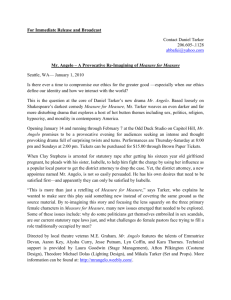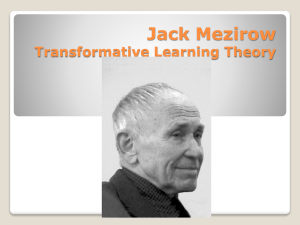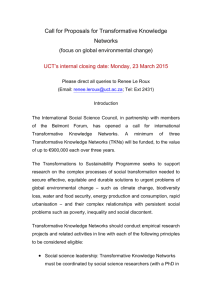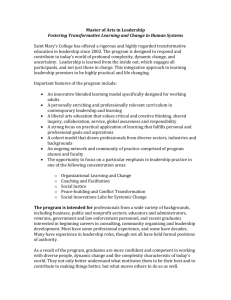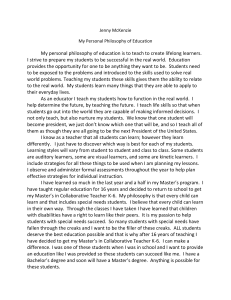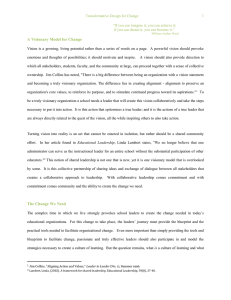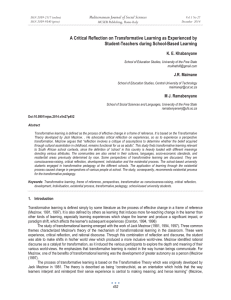Transformative, Collaborative, and Integrated Development
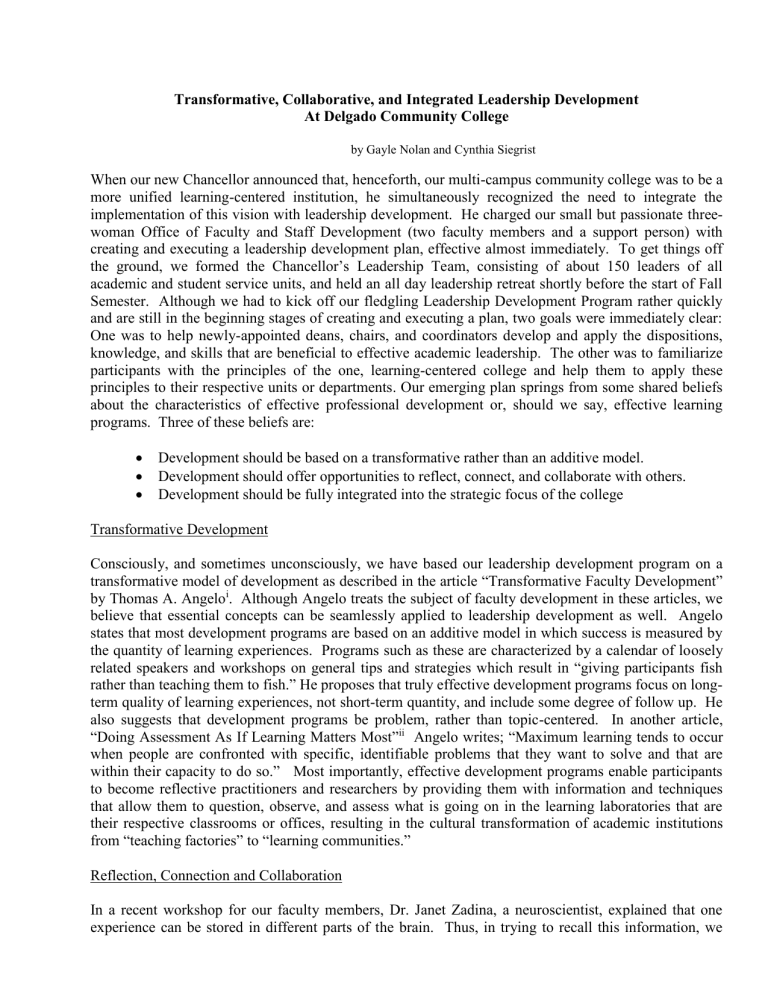
Transformative, Collaborative, and Integrated Leadership Development
At Delgado Community College
by Gayle Nolan and Cynthia Siegrist
When our new Chancellor announced that, henceforth, our multi-campus community college was to be a more unified learning-centered institution, he simultaneously recognized the need to integrate the implementation of this vision with leadership development. He charged our small but passionate threewoman Office of Faculty and Staff Development (two faculty members and a support person) with creating and executing a leadership development plan, effective almost immediately. To get things off the ground, we formed the Chancellor’s Leadership Team, consisting of about 150 leaders of all academic and student service units, and held an all day leadership retreat shortly before the start of Fall
Semester. Although we had to kick off our fledgling Leadership Development Program rather quickly and are still in the beginning stages of creating and executing a plan, two goals were immediately clear:
One was to help newly-appointed deans, chairs, and coordinators develop and apply the dispositions, knowledge, and skills that are beneficial to effective academic leadership. The other was to familiarize participants with the principles of the one, learning-centered college and help them to apply these principles to their respective units or departments. Our emerging plan springs from some shared beliefs about the characteristics of effective professional development or, should we say, effective learning programs. Three of these beliefs are:
Development should be based on a transformative rather than an additive model.
Development should offer opportunities to reflect, connect, and collaborate with others.
Development should be fully integrated into the strategic focus of the college
Transformative Development
Consciously, and sometimes unconsciously, we have based our leadership development program on a transformative model of development as described in the article “Transformative Faculty Development” by Thomas A. Angelo i
. Although Angelo treats the subject of faculty development in these articles, we believe that essential concepts can be seamlessly applied to leadership development as well. Angelo states that most development programs are based on an additive model in which success is measured by the quantity of learning experiences. Programs such as these are characterized by a calendar of loosely related speakers and workshops on general tips and strategies which result in “giving participants fish rather than teaching them to fish.” He proposes that truly effective development programs focus on longterm quality of learning experiences, not short-term quantity, and include some degree of follow up. He also suggests that development programs be problem, rather than topic-centered. In another article,
“Doing Assessment As If Learning Matters Most” ii
Angelo writes; “Maximum learning tends to occur when people are confronted with specific, identifiable problems that they want to solve and that are within their capacity to do so.” Most importantly, effective development programs enable participants to become reflective practitioners and researchers by providing them with information and techniques that allow them to question, observe, and assess what is going on in the learning laboratories that are their respective classrooms or offices, resulting in the cultural transformation of academic institutions from “teaching factories” to “learning communities.”
Reflection, Connection and Collaboration
In a recent workshop for our faculty members, Dr. Janet Zadina, a neuroscientist, explained that one experience can be stored in different parts of the brain. Thus, in trying to recall this information, we
may need time to make all the connections necessary to reconstruct the information. In Thinking about
Teaching and Learning, iii
Robert Leamnson further points out that target information is easier to retrieve when “mental circuitry gets ‘burned in’ by using a particular circuit repeatedly in a large variety of situations.” This certainly implies at least two things: Practice does make more perfect, and the richer and fuller a learning experience is, the more neural connections will be made. Part of practice and a rich learning experience, he suggests, is inspiring and instructing learners to verbalize and articulate their thoughts.
If one way to learn things is to make connections in the brain, another way to connect is by collaborating with others within the learning community. Research shows that collaborative learning environments wherein learners work in groups toward a common goal are more effective than individualized ones, perhaps in part because collaboration requires verbalization and communication among members of the group. In the October 2004 issue of the Chief Learning Officer, the article
“Collaborative Tools in the Learning Continuum” iv
sums it up this way:
The learner who learns best is the one who organizes, summarizes, elaborates, explains and defends his or her ideas in the process of collaborating.
More learning occurs in an environment of peer support and encouragement because learners eagerly work harder and longer.
Many opportunities to reflect, connect, and collaborate have been incorporated into our leadership development plan. Expected institutional outcomes of this transformative, collaborative model of learning and development are even greater than the expected impact on individual learners, as indicated above.
Institutional Integration of Development
Outside of academia, (i.e., in the business world), executive development is clearly recognized as a way to integrate institutional learning with strategic planning in such a way that a leadership development program can also help craft, and execute policy. In “The Strategic Role of Executive Development,” v
Scott Saslow describes executive development programs as being either discreet or integrated. The article suggests that development as a discreet process is often ineffective. Development strategies that are created independently of the strategic plan may be irrelevant, unrealistic, poorly communicated and inconsistently executed, thereby resulting in a failure to promote a sufficient amount of growth in the desired timelines. Organizations with a discreet development process are often characterized by a need to bring in outside talent to fill leadership positions.
On the other hand, he suggests that organizations that can fully integrate development into strategic planning and the implementation of strategic goals “are more likely to have robust strategies and will perform better.” Integrated development plans place responsibility for the communication, requisite training, and implementation of plans to all levels of employees. Moreover, integrated development not only facilitates the execution of strategic plans but can improve the design of these plans or lead to the development of new goals and objectives, thereby driving further changes within the organization.
Our Emerging Leadership Development Plan
As we develop the idealistic plan of transforming the culture of the college to one of “collegiate learning” through our Leadership Development Plan, we are also addressing the immediate objectives of
leadership development in general and development in the areas of the one, learning-centered college in particular. To meet our leadership development goal, we selected a core text, Communication Skills for
Academic Leaders vi , distributed it to leadership team members, and designed a series of collaborative leadership workshops based on the book. The author, Dr. Mary Lou Higgerson, was invited to facilitate the first workshop. At the workshops, participants engaged in activities that allowed them to articulate, discuss, reflect on, practice, and apply what they’ve learned.
Typically, we like to start or end development sessions by asking participants to discuss the following questions in groups. I) What did you learn (from the last reading assignment, activity, reading, etc.) that had an impact on you? and 2) How might you apply it? To our leadership development sessions, we also imagine employing a three-step process that is outlined by Thomas A. Angelo in the article,
“Doing Assessment As If Learning Mattered Most” in which participants identify a problem they are having, write down what they judge to be the best solution, determine if the group could and would actually implement it. If the answer to any of the latter questions is “no,” the problem is not worth taking on. If the answer is “yes,” it is time to further explore the application of the solution.
To familiarize participants with the concepts and principles of the one, learning-centered college, our
Chancellor has lead an effort to invite the leading experts in the field to work with our leadership team and other interested faculty and staff. After each visit, we hope to follow up with opportunities for further reading, discussion, and examination of ways that the new concepts, principles, or techniques could be applied. In order to integrate and institutionalize our development plan, the Chancellor has made participation mandatory and intends to provide certificates of achievement that list the leadership activities in which participants have engaged.
Challenges and Rewards
The challenge ahead is still a formidable one. As administrators move through personal leadership development towards the culture of a learning community, they must also implement the college’s strategic plan. As in most institutions of higher education, we have a tradition of departments and offices and their respective units working independently of one another (including working toward independent and sometimes conflicting goals). Consequently, changes most often are adopted in only piecemeal and superficial ways.
Still, the initial attempts to cross inter and intra-departmental lines have been met with enthusiasm. Not long ago, we sent out an email to all and the members of newly formed “Chancellor’s Leadership Team” that outlined the leadership development focus and activities for the upcoming academic year. We received many positive and enthusiastic responses. Some in leadership positions who weren’t sure they were included called to see if they could be part of the team. Academic and support service department heads recommended including additional members of their departments. Departments ordered more copies of the book. The campus newsletter contacted us for further information, and we were encouraged to write an article about our new Leadership Development Program. We are beginning to see that, when offered the opportunity to grow professionally, leaders will respond by taking ownership of the institution’s strategic plan as they communicate across and within long established departmental lines.
The overarching goal in our Leadership Development plan is to help transform the college into a learning community in which student and academic affairs leaders carry out the strategic focus of the college in a way that is supported, coordinated, and executed through inter and intra-departmental
collaboration. By building a base of well-informed, thoughtful, leaders who have repeatedly collaborated on solving institutional problems and building support structures, we may in fact achieve our goal—a unified, multi-campus college of learners.
Delgado Community College, founded in 1921, is Louisiana’s oldest and largest community college. It is ranked 15 th
among the nation’s fastest-growing two-year colleges with 10,000 or more students. In the fall of 2004, the college experienced its largest credit enrollment ever with 16,670 students enrolled.
Another 16,000 individuals are served each year in workforce and continuing education programs.
Programs at the college consistently rank among the best nationally. The Charity School of Nursing is ranked14 th in the nation for the number of degrees conferred, while Allied Health is 16 th .
With three campus locations at City Park, the West Bank, and the School of Nursing, plus five additional outreach locations including St. Tammany’s Northshore, Delgado is growing to meet the workforce training and education challenges for the New Orleans region in health care, business and technology, maritime, hospitality, and transportation. i Angelo, Thomas. (1994). “Transformative Faculty Development.” In T. O’Banion, ed., Teaching and Learning in the
Community College.
Community College Press, AACC. ii Angelo, Thomas. (1999) “Doing Assessment As If Learning Matters Most.” AAHE Bulletin , May 1999. iii Leamnson, Robert. (1999 ). Thinking About Teaching and Learning . Sterling: Stylus Publishing iv Driscoll, Margaret. (2004). “Collaborative Tools in the Learning Continuum.” Chief Learning Officer , 2, no.10 (October
2004) v Saslow, Scott. (2004). “The Strategic Role of Executive Development.” Chief Learning Officer , 2, no. 10 (October 2004) vi Higgerson, Mary Lou. (1996). Communication Skills for Department Chairs . Bolton: Anker Publishing Company, Inc.

